Australian Aboriginal Art Is Having a Radical Moment
Photos courtesy of the Frost Art Museum FIU Visual Arts Features Gulumbu Yunupingu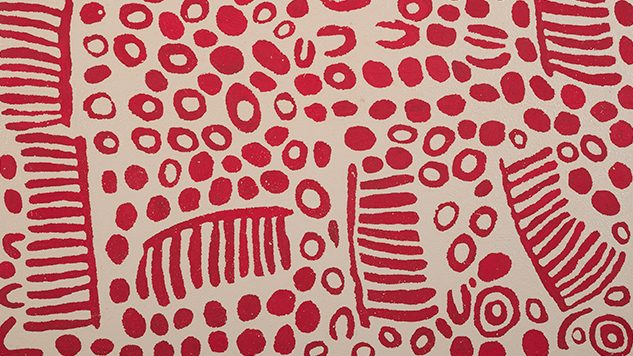
The Australian Aboriginal art market is reportedly worth almost $200 million. Although the contemporary art movement on the continent is a century old, it wasn’t until the late 1980s that Aboriginal women were invited to paint for the Australian art market. Once given the widespread opportunity, Aboriginal women showed themselves to be greater experimentalists than their male counterparts. They were unafraid to take risks or work in the abstract. Their proclivity for innovation sent a jolt through the Aboriginal contemporary art community, and that proved to be a “radical moment” for the movement, says Henry Skerritt, Australian art historian and curator of the Kluge-Ruhe Aboriginal Art Collection of the University of Virginia. “Women have been such driving, dominant, important, influential forces. They were able to propel the movement because they saw the potential to hold their culture strong and their communities together.” 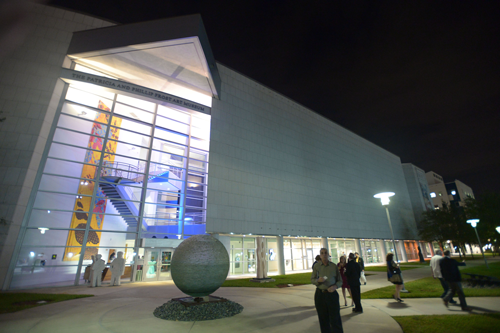
While Aboriginal Australian art is revered on the island continent, the practice is not well known in North America. Skerritt hopes that will change with the exhibition Marking the Infinite, which features never-before-seen artwork from nine female artists who have shaped the movement. The rolling exhibition opened the second leg of its tour on January 28 at the Patricia and Phillip Frost Art Museum FIU in Miami, Florida, and will run at the space through May 7. There’s been a great deal of controversy surrounding fake Indigenous Art as of late, so a show celebrating the rich, authentic history behind true Aboriginal artists couldn’t be more timely.
Marking the Infinite is the first exhibition dedicated to Aboriginal female artists to tour in the United States.  The show, which draws entirely from the Debra and Dennis Scholl Collection, aims to bridge the cultural divide between North America and Australia. Skerritt says the vanguard artists featured in the show “testify to the persistence of their culture.”
The show, which draws entirely from the Debra and Dennis Scholl Collection, aims to bridge the cultural divide between North America and Australia. Skerritt says the vanguard artists featured in the show “testify to the persistence of their culture.”
These respected artist-matriarchs live in remote villages throughout Australia. Nonggirrnga Marawili, Yukultji Napangati, Angelina Pwerle, Carlene West, Regina Pilawuk Wilson, Lena Yarinkura, and Nyapanyapa Yunupingu, 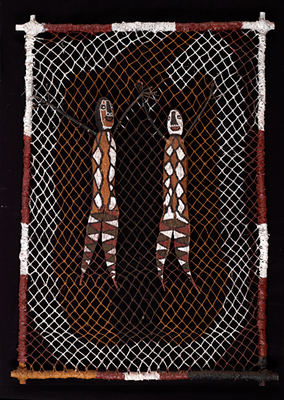 as well as the late Gulumbu Yunupingu and late Wintjiya Napaltjarri all use art as way not only to express their deep knowledge, but also to make the viewer “recognize the power of their culture even if you don’t quite understand it.”
as well as the late Gulumbu Yunupingu and late Wintjiya Napaltjarri all use art as way not only to express their deep knowledge, but also to make the viewer “recognize the power of their culture even if you don’t quite understand it.”
“You could just disappear into some of these,” says Dennis Scholl, a Miami-based philanthropist who commissioned the artwork directly from the women. “You get closer and closer to them [and] you forget where you are because they’re so inviting.”
In many ways, Marking the Infinite is a political statement. On the surface, the exhibition uses bold artwork to draw attention to a vibrant art scene thousands of miles away. But these Aboriginal women are also creating art to ensure their language, their country and their way of seeing the world survives in an increasingly digital world.
“These artists are painting their culture,” says Scholl. “They know that if they don’t get their culture out into the world, they’re going to lose it.”
Featured Artists
1. Gulumbu Yunupingu
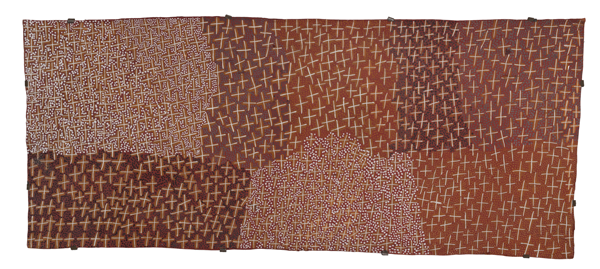
The late Gulumbu Yunupingu was an award-winning Aboriginal artist and women’s leader born in Arnhem Land in North Australia. As an artist, she put her modern twist on the traditional designs and ceremonial stories that shaped her worldview. To Skerritt, no artist’s work best encapsulates the theme of Marking the Infinite quote like Yunupingu’s field of stars. “One of the central ideas of the show is that we are all different, but we are all human,” says Skerritt. “She transformed that into a metaphor that says, ‘We are all people under the same stars’.”
2. Regina Pilawuk Wilson

Like Yunupingu, Regina Pilawuk Wilson hails from Australia’s Northern Territory. She’s an award-winning artist known for her large syaw — meaning fishnet — paintings. For Marking the Infinite, Wilson produced her two largest artworks to-date, which gives testament to her sheer ambition as an artist, says Skerritt. In fact, Wilson’s piece, “Sun Mat,” serves as the cover of the catalogue for Marking the Infinite. The painting is a spiraling kaleidoscope of blues, reds, oranges, purples and pinks that reaches about 9-feet tall and stretches about 12-feet wide. “It’s a beautiful, gigantic painting,” says Scholl.
3. Carlene West
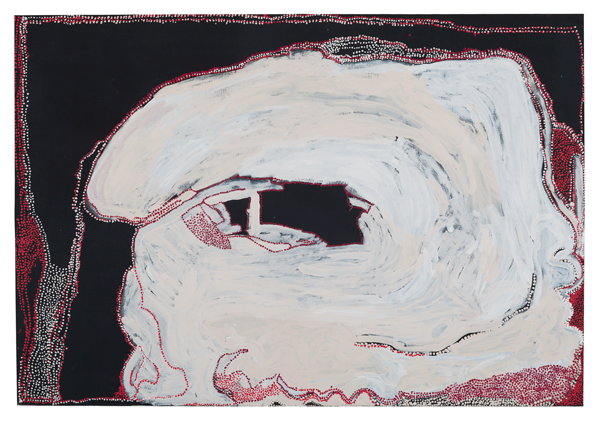
Both Skerritt and Scholl consider Carlene West’s artwork among the most powerful in the exhibition. West, who lives in Australia’s Southern Desert region, had a “short but sharp” painting career before health issues caused her to retire, Skerritt says. Her artwork reveals someone who is sensing “the end of their time on the planet and becoming one with the landscape.” To Scholl, West’s work was “a revelation.” The Marking the Infinite exhibition features the “last gigantic, monumental burst” of artwork before she retired. “Those paintings really take your breath away when you look at then,” he says.
About the photos:
Artwork courtesy of the individual artists and the Frost Art Museum FIU.
Mantua Nangala, Dennis Scholl, and Yukultji Napangati at the Papunya Tula Artists studio, Kiwirrkurra, Western Australia, August 2014. Photograph by Henry F. Skerritt